By Dow Jones Insight Staff
As the start of the Beijing Olympic Games draws closer, coverage of athlete doping is starting to catch up with the hot-button issue of pollution concerns, according to analysis of traditional and social media sources tracked by Dow Jones Insight.
While there still was more coverage of Beijing’s polluted air and water (2,094 mentions) than doping (1,186 mentions) in the 10 days from July 14 to 23, doping coverage has been increasing in the wake of coverage of the World Anti-Doping Agency’s vows that the Beijing Games would be “the cleanest Games in history.” WADA announced the existence of a new test to detect the presence of erythropoietin (EPO), a banned blood booster, which was previously considered undetectable. According to WADA, the new test detects the presence of a molecule implanted into EPO during the manufacturing process. It was this test that nabbed Italian cyclist Ricardo Ricco during the 2008 Tour de France.
Mentions of doping increased to a high of 177 on July 24 with coverage of U.S. swimmer Jessica Hardy’s positive test for a banned substance. Hardy tested positive for clenbuterol, a stimulant. The next move for Hardy, who denies cheating, is unclear, but she can pursue appeals through the American Arbitration Association and the Court of Arbitration for Sport in order to hold onto her spot on the U.S. team.
This increase in doping coverage was also driven by news that Greek sprinter Katerina Thanou was included on Greece’s official roster for Beijing. Thanou served a two-year ban after missing a mandatory doping test prior to the 2004 Athens Games. Thanou had won a silver medal in the 100 meters in Sydney in 2000.
Coverage of environmental issues seemed to be subsiding during the past week, following a high of 293 mentions on July 21 driven by green algae on the sailing course, soot in the air and Beijing’s last-minute plans to clean it all up. But that changed again early this week with reports that Beijing’s attempts to reduce the soot in the air were not working as hoped and more measures would have to be taken.
While there still was more coverage of Beijing’s polluted air and water (2,094 mentions) than doping (1,186 mentions) in the 10 days from July 14 to 23, doping coverage has been increasing in the wake of coverage of the World Anti-Doping Agency’s vows that the Beijing Games would be “the cleanest Games in history.” WADA announced the existence of a new test to detect the presence of erythropoietin (EPO), a banned blood booster, which was previously considered undetectable. According to WADA, the new test detects the presence of a molecule implanted into EPO during the manufacturing process. It was this test that nabbed Italian cyclist Ricardo Ricco during the 2008 Tour de France.
Mentions of doping increased to a high of 177 on July 24 with coverage of U.S. swimmer Jessica Hardy’s positive test for a banned substance. Hardy tested positive for clenbuterol, a stimulant. The next move for Hardy, who denies cheating, is unclear, but she can pursue appeals through the American Arbitration Association and the Court of Arbitration for Sport in order to hold onto her spot on the U.S. team.
This increase in doping coverage was also driven by news that Greek sprinter Katerina Thanou was included on Greece’s official roster for Beijing. Thanou served a two-year ban after missing a mandatory doping test prior to the 2004 Athens Games. Thanou had won a silver medal in the 100 meters in Sydney in 2000.
Coverage of environmental issues seemed to be subsiding during the past week, following a high of 293 mentions on July 21 driven by green algae on the sailing course, soot in the air and Beijing’s last-minute plans to clean it all up. But that changed again early this week with reports that Beijing’s attempts to reduce the soot in the air were not working as hoped and more measures would have to be taken.
Methodology: Analysis includes the English-language sources taken from a database of 6,000 newspapers, wires, magazines, radio and TV transcripts; about 13,000 current-awareness news sites; 60,000 message boards and about two million blogs.

No comments:
Post a Comment